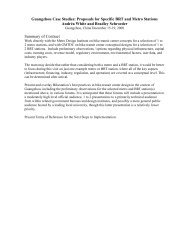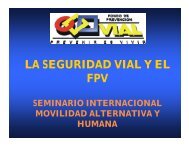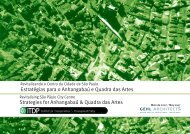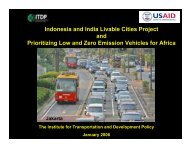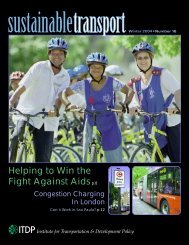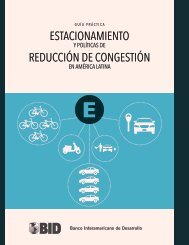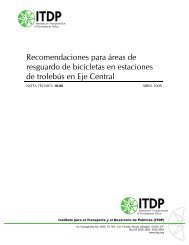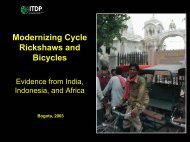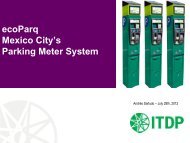Europe's Vibrant New Low Car(bon) Communities - ITDP | Institute ...
Europe's Vibrant New Low Car(bon) Communities - ITDP | Institute ...
Europe's Vibrant New Low Car(bon) Communities - ITDP | Institute ...
You also want an ePaper? Increase the reach of your titles
YUMPU automatically turns print PDFs into web optimized ePapers that Google loves.
Greenwich Millennium Village 11<br />
with 20% designated as affordable housing. For the affordable<br />
housing portion of the development, GMVL is working in association<br />
with social housing partners Moat Housing. GMVL also agreed to<br />
contribute a specified sum for bus improvements in the area and to<br />
submit a parking garage management plan.<br />
In return, English Partnerships agreed to fund the Millennium<br />
Busway, a bus only lane running through the development, as well as<br />
a state of the art integrated school and health center, which opened<br />
in 2001 (see Figure 1). English Partnerships also agreed to produce an<br />
annual travel monitoring study including analysis of mode split and<br />
parking demand of GMV residents in addition to a strategy plan for<br />
reducing car use.<br />
Construction of GMV began in 1999 and the first homes were<br />
occupied by 2000. Phases 1 and 2 of the building process were completed<br />
by 2002, producing 1,095 residential units, a village square<br />
with shops, an artificial lake and an ecology park.<br />
In 2006 a new Section 106 Agreement was signed between the<br />
Greenwich Peninsula landowners, English Partnerships, and GMVL.<br />
This agreement increased the planned development size from 1,400<br />
to 2,900 residential units and increased the required share of affordable<br />
housing from 20% to 35%. The agreement laid out the plans for<br />
Phases 3 and 4 of the development which will include construction<br />
of around 1,800 additional new homes, 15,000 square feet of retail<br />
spaces, 70,000 square feet of work space, a community center and<br />
a nursery. The planned completion date for Phases 3 and 4 is 2014<br />
(English Partnerships Website).<br />
key policy and design strategy<br />
The Millennium <strong>Communities</strong> Programme has recognized reduced<br />
car dependency as a key sustainability issue. This is especially<br />
apparent in the city of London which has limited room for additional<br />
parking spaces and a high level of traffic congestion. Spurred by<br />
these concerns, GMV has incorporated several transportation<br />
demand management strategies aimed at reducing car dependency<br />
and promoting other, more sustainable forms of transport.<br />
Parking<br />
As part of its strategy to reduce car dependency, motor vehicle parking<br />
at GMV is restricted and generally located away from individual<br />
properties. Parking spaces are only available for 80% of units. Two<br />
floors of parking garage are located beneath two of the apartment<br />
buildings built during Phase 1. In Phase 2, car parking facilities were<br />
separated from apartment units and located at the edge of the development.<br />
Overall there are 884 parking spaces in the development.<br />
Further, parking spaces are unbundled from apartment units, so<br />
residents who choose to have a parking space must pay for it separately<br />
from their residence. Residents don’t pay for a specific parking space,<br />
but rather for a “right to park,” which means they can enter the parking<br />
garage and must then search for an available space. Prices per space<br />
have gone up since the development was first built, but the current price<br />
is 17,500 gbp per parking space (Marcello Burbante, pers. comm.).<br />
Only residents who have purchased a space are allowed to park in<br />
the garages; visitors are not allowed. Visitors are expected either to<br />
park temporarily in the bays on the main roads, which are frequently<br />
ticketed by the council, or in the public parking lot next to the North<br />
Greenwich transit station located 0.8 kilometers northwest of GMV.<br />
section 106 agreements<br />
These agreements refer to Section 106 of the British<br />
Parliament’s Town and Country Planning Act of 1990,<br />
which regulates the development of land in England<br />
and Wales. Section 106 permits local authorities and<br />
developers to make agreements over the use of land,<br />
including planning obligations by the developer<br />
to contribute towards sustainable communities<br />
and offset the costs of the external effects of the<br />
development. Contributions by the developer<br />
may include cash, infrastructure investments or<br />
provision of services. Examples include provision<br />
of new schools, public space, affordable housing,<br />
new roads and public transport. Section 106<br />
agreements are legally binding and are linked to the<br />
granting of planning permission. Each agreement<br />
is different and depends on the unique needs of<br />
each community. Some agreements may include<br />
measures aimed at reducing transport-related<br />
emissions. Transport-related measures that have<br />
been included by the Greenwich Council (specifically<br />
for the Woolwich Town Centre Development) include:<br />
provision of carsharing, controls on parking permits,<br />
emission-related parking charges, provision of<br />
electric vehicle charging points and use of bio-fuel in<br />
delivery vehicles (Birch 2010).<br />
However, during school holidays people are informally allowed to<br />
park in the school’s parking lot. In addition, residents often rent out<br />
their spaces to neighbors during the winter holidays by advertising<br />
on bulletin boards in the shared spaces. In this way, residents have<br />
taken it upon themselves to manage the existing parking supply as<br />
efficiently as possible, treating it as a valuable commodity.<br />
Cycling and Pedestrian Infrastructure<br />
On the flip side, GMV strives to promote cycling and walking. A<br />
network of cycle and pedestrian routes runs throughout the village<br />
and beyond, connecting the development to the surrounding areas.<br />
For example, a pedestrian walkway leads from GMV to The O2 Arena,<br />
a large sports and music venue located in the Millennium Dome on<br />
the northern side of the Greenwich Peninsula. Within GMV, secure<br />
bicycle storage facilities are provided for every housing unit and<br />
2–3 bicycle parking spaces are available per unit, including several<br />
covered, weather-protective bicycle parking facilities (Photo 4).<br />
<strong>Car</strong>sharing<br />
Two carsharing vehicles, provided by Streetcar, are located just to<br />
the north of GMV (Streetcar Website). These vehicles are located in a<br />
car bay on John Harrison Way, which boarders GMV. In addition, two<br />
Streetcar carsharing vehicles are located in a parking lot off of Tunnel<br />
Avenue, about half a kilometer south of GMV. Other than these four





